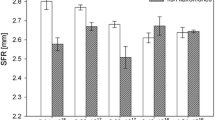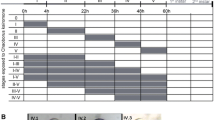Abstract
Exposing Daphnia to the presence of a predator at different stages of ontogenesis leads to different reactions. Predator-induced changes of life history parameters related to the first reproduction schedule, as age and size at first reproduction, take place in the stage preceding that one in which vitellogenesis occurs. Determination of the amount of energy allocated to this first reproduction, including offspring number, occurs in the first 24-h of life. In case of parameters related to reproduction schedule, time since induction until the release of the first clutch of offspring is tens of hours; in case of allocation patterns – more than 100. This suggests that Daphnia do not “remember” the information of a potential threat but, instead, the decisions on future development are undertaken once they have estimated the reigning predation regime. Shortening of the period during which eggs are carried in the brood chamber, thus shortening the time when Daphnia are more easily visible, may be another adaptation to reduce danger from fish predation and so increasing the probability of survival until the first successful reproduction.
Similar content being viewed by others
References
Agraval, A. A., C. Laforsch & R. Tollrian, 1999. Transgenerational induction of defences in animals and plants. Nature 401: 60-63.
Alekseev, V. & W. Lampert, 2001. Maternal control of resting egg production in Daphnia. Nature 414: 899-901.
Dawidowicz, P., 1993. Diel vertical migration in Chaoborus flavicans: population patterns vs. individual tracks. Archiv für Hydrobiologie, Beihefte Ergebn, Limnologie, 39: 19-28.
Dawidowicz, P. & C. J. Loose, 1992. Metabolic costs during predator-induced diel vertical migration of Daphnia. Limnology and Oceanography 37: 1589-1595.
Dodson, S. I., 1989. The ecological role of chemical stimuli for the zooplankton: predator-induced morphology in Daphnia. Oecologia 78: 361-367.
Dodson, S. I. & J. E. Havel, 1988. Indirect prey effects: some morphological and life history responses of Daphnia pulex exposed to Notonecta undulata. Limnology and Oceanography 33: 1274-1285.
Klüttgen, B., U. Dümler, M. Engels & H. T. Ratte, 1994. ADAM, an articial freshwater for the culture of zooplankton. Water Research 28: 743-746.
Lampert, W., 1991. The dynamics of Daphnia magna in a shallow lake. Verh. Internat. Verein. Limnol. 24: 795-798.
Macháček, J., 1991. Indirect effect of planktivorous fish on the growth and reproduction of Daphnia galeata. Hydrobiologia 225: 193-198.
Macháček, J., 1995. Inducibility of life history changes by fish kairomone in various developmental stages of Daphnia. Journal of Plankton Research 17: 1513-1520.
Mikulski, A., 2000. Does Daphnia really minimize its size at first reproduction in the presence of fish? Verh. Internat. Verein. Limnol. 27: 2888-2891.
Riessen, H. P., 1993. Predator-induced life history shifts in Daphnia: a synthesis of studies using meta-analysis. Canadian Journal of Fisheries and Aquatic Sciences 56: 2487-2494.
Sakwiñska, O., 2002. Response to fish kairomone in Daphnia galeata life history traits relies on shift to earlier instar at maturation. Oecologia 131: 409-417.
Stibor, H., 1992. Predator-induced life-history shifts in a freshwater cladoceran. Oecologia 192: 162-165.
Sokal, R. R. & R. J. Rolf, 1981. Biometry. W. H. Freeman & Company, New York.
Weider, L. J. & J. Pijanowska, 1993. Plasticity of Daphnia life histories in response to chemical cues from predators. Oikos 67: 385-392.
Author information
Authors and Affiliations
Rights and permissions
About this article
Cite this article
Mikulski, A., Lipowska, D. & Pijanowska, J. Ontogenetic Changes in Daphnia Responsiveness to Fish Kairomone. Hydrobiologia 526, 219–224 (2004). https://doi.org/10.1023/B:HYDR.0000041601.26048.6d
Issue Date:
DOI: https://doi.org/10.1023/B:HYDR.0000041601.26048.6d




